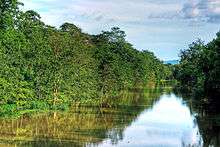Kolong
The Kolong River is a tributary of the Brahmaputra River, which divert out from the Brahamputra river in Hatimura region of Jakhalabandha (Nagaon district, Assam, India), and meets the same at Kolongpar near Guwahati. The tributary is about 250 kilometres (160 mi) long and flows through the districts of Nagaon, Morigaon and Kamrup; on the way, several smaller streams (Diju, Misa and others) meet it. The river flows through the heart of the Nagaon urban area dividing the town into Nagaon and Haiborgaon.

History and cultural influence
Not much is known about the pre-colonial period about the river. In the colonial period, though, the river was known to be widely used for passenger and goods transport, specially because the road and rail network was un-/underdeveloped during that period. That is the reason why the British colonial administration almost established the district headquarters in Puranigudam, on the bank of the river.
Till the colonial period, the Kolong river and smaller streams feeding the river were the main sources of potable water; and most of the villages got settled on their banks. People had got heartily attached to the river, and as one folktale says, it was just "Kolong" for them, they refused to say it even a river.
In those days, the river created havoc by flooding in the lowland areas in the present Nagaon and Morigaon districts during the rainy season, as it received water not only from the smaller streams, but also from the overflowing Brahamaputra. Sometime in 1960s, a major flood paused a major threat to existence of the Nagaon town itself, which lies in a lowland area. Therefore, the mouth of the river in Hatimura region of Jakhalabandha was permanently closed subsequently, allowing the river to carry the water only from the smaller streams to Brahamaputra. Following this, the threat of flood had disappeared, but due to lack of enough water, specially during the dry winter, the river almost dried to its half; in several places, the river presently looks like a closed pond, water covered with water hyacinth. Due to lack of current, many sand-sores got formed in and around the river. Its population of flora and fauna also diminished. Several water bodies also had got adversely affected in terms of their flora and fauna.
Numerous fictional and non-fictional, famous and not-so-famous articles, poems etc. has been written taking the river as a main subject/ character. Famous Assamese poet, Late Nabakanta Baruah Nabakanta Barua had authored a famous novel [Kokadeutar Had: The Bone of (my)Grandfather] fictionalizing the river and its history.
There are several Bihugeets (song sung during Bihu) and modern Assamese songs also have mention of Kolong.
21st century

The river is almost dry now and hardly seen flowing in dry season. Several organizations including North East Centre for Environmental Research and Development (NE-CERD) are advocating re-opening of the river-mouth for its revival. NE-CERD has also said to have performed a feasibility study recently regarding such a project in their website. Recently a committee has been formed under the leadership of Homen Borgohain to revive the river so that transportation and irrigation projects along river valley can be started immediately. It is decided that a sluice gate has to be installed at the mouth of the River at Hatimora, so that the flow of the river can be controlled easily.[1]
References
- ↑ Bhuyan, Pradip Kumar. "Kolong: Death of a River – and an Ecosystem". NE-CERD. Retrieved 18 July 2009.
| ||||||||||||||||||||||
Coordinates: 25°57′11″N 92°46′46″E / 25.95306°N 92.77944°E
The Restoration & Beautification of The Kolong River-Published in The Amar Assam on 7 October 2013 Author -Ribhaba Bharali.